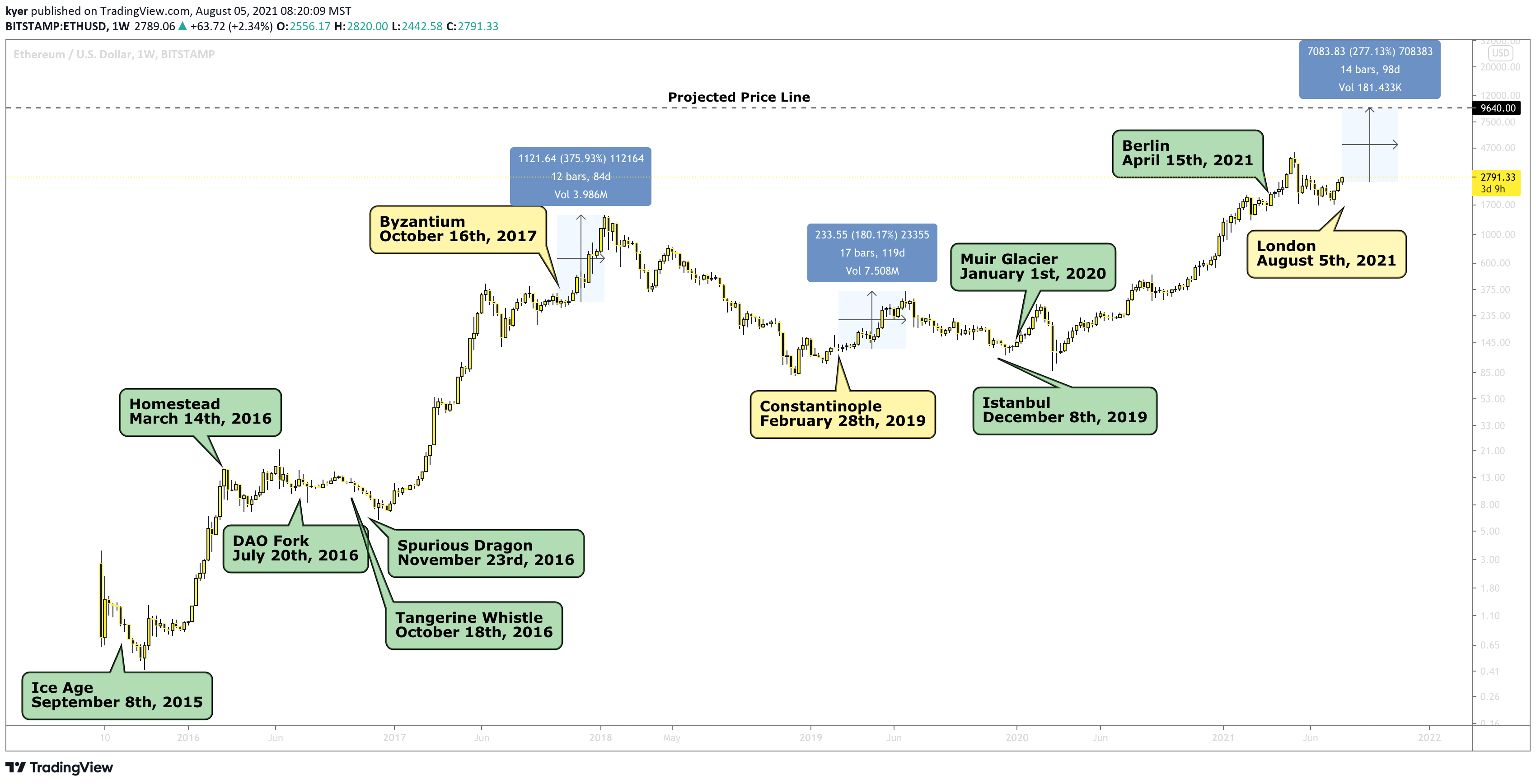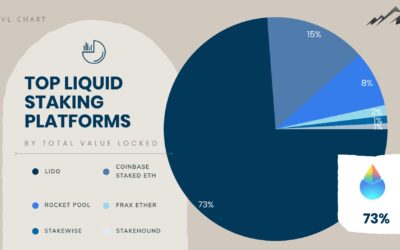Three weeks after the London hard fork block containing EIP-1559 has been mined, just about 100,000 ETH have been burned (taken out of the supply). Over the course of 6 years, over 12 million blocks have been mined and 12 hard forks have occurred. Today, i’m going to breakdown the hard forks and each of its effect on the price of Ethereum.
Starting off first with Frontier on July 30th, 2015, this fork marks the first official Ethereum release. This launch contained the Genesis block with a little over 72 million ETH that was “premined”, of which about 12 million was allocated for the Ethereum development fund.
After the initial release of Ethereum (Frontier), there have been 12 forks improving the network’s protocol. The yellow color coded callouts have been the hard forks that have reduced the issuance on the Ethereum network.
Ice Age — September 8th, 2015 — Block #200,000
The first time the Difficulty Bomb concept came up was in 2015. At that time, Stephan Tual, former Chief Commercial Official at Ethereum, mentioned it in a blog post announcing the first Frontier patch. According to him, starting from the creation of the block #200,000, there will be an exponential increase the difficulty, increasing block resolution time. Besides, this is how the blockchain will switch to PoS from PoW in time for the final milestone phase, Serenity.
The real ice age would take until 2021 before the real effects of the difficulty bomb become obvious (Muir Glacier Fork Patch).
Homestead — March 14th, 2016 — Block #1,150,000
Homestead comes with a few backward-incompatible protocol changes, and therefore will require a hard fork.
- EIP-2: eliminates the excess incentive to create contracts via transactions, where the cost is 21000, rather than contracts, where the cost is 32000.
- EIP-2 also fixes the protocol “bug” that with the help of suicide refunds, it is currently possible to make a simple ether value transfer using only 11664 gas.
- EIP-2 eliminates the excess incentive to set the timestamp difference in the result of a contract creation process, rather than the current “success, fail, or empty contract” trichotomy
- EIP-7 makes it much easier for a contract to store another address as a mutable source of code and “pass through” calls to it, as the child code would execute in essentially the same environment as the parent.
- EIP-8: makes sure that all client software in use on the Ethereum network can cope with future protocol upgrades.
DAO Fork — July 20th, 2016 — Block #1,920,000
A vulnerability was found inside the DAO contract and if no action would’ve been taken, the attacker would single-handedly have owned 4.4% of the entire supply of ETH. Subsequently, a controversial proposal (EIP-779) was released in order to change the code of the attacker’s lockup contract, allowing everybody to withdraw their ETH from the DAO contract.
On July 20th, a majority of mining power support a fork which implemented this change, while a smaller community decided to split off and rename the old chain to Ethereum Classic.
Tangerine Whistle — October 18th, 2016 — Block #2,463,000
Tangerine Whistle only contained one EIP, EIP-150. This proposal repriced some opcodes to prevent denial-of-service attacks from being worthwhile, adding a flat penalty of 300 gas on top of the costs calculated in this table to account for the cost of loading the code.
Spurious Dragon — November 23rd, 2016 — Block #2,675,000
“Spurious Dragon” is the second hard fork of the two-round hard fork response to the DoS attacks on the Ethereum network in September and October. The previous hard fork (“Tangerine Whistle”) addressed immediate network health issues due to the attacks. The upcoming hard fork addresses important but less pressing matters such as further tuning opcode pricing to prevent future attacks on the network, enabling “debloat” of the blockchain state, and adding replay attack protection.
Byzantium — October 16th, 2017 — Block #4,370,000
Byzantium is the fifth hard fork Ethereum has implemented; Nine Ethereum Improvement Protocols were designed to increase the network’s privacy, security, and scalability (unnoticeable to the average user). Some are geared towards improving smart contracts by allowing developers to code planned contract upgrades as well as making them less prone to cyber attacks.
A major EIP also prepares Ethereum for the integration of ZK-Snarks. Once implemented, this technology is expected to allow users of the network make transactions that cannot be traced, like the cryptocurrency Zcash.
The main EIP takeaway from this hard fork is the block issuance rate. This number during Frontier (mainnet launch) was 5 ETH, which has now been reduced to 3 ETH per block reward.
Constantinople / St. Petersburg — February 28th, 2019 — Block #7,280,000
Constantinople is the sixth hard fork Ethereum has implemented with four out of five planned Ethereum Improvement Proposals not being noticeable to the average user. The only user group that experienced a noticeable change is the miners, which Constantinople and St. Petersburg reduced the block reward issuance from 3 to 2 Ether.
Istanbul — December 8th, 2019 — Block #9,069,000
Istanbul includes six Ethereum Improvement Proposals (EIPs), specific code changes to the ethereum protocol, including EIPs: 152, 1108, 1344, 1844, 2028 and 2200.
The main issues being addressed by the six EIPs are:
- Denial-of-service (DDoS) attack resilience (EIP 1344)
- Interoperability with equihash-based proof-of-work (PoW) cryptocurrencies such as zcash (EIP 152)
- Gas costs (EIPs 1108, 2028, 2200)
Muir Glacier — January 1st, 2020 — Block #9,200,000
The Muir Glacier network upgrade was kept simple with one Ethereum Improvement Proposal (EIP). EIP-2384 effectively delays the difficulty bomb for another 4,000,000 blocks. Pushing back the goal post.
Berlin — April 15th, 2021 — Block #12,224,000
The Berlin hard fork incorporates four EIPs that tinker with gas prices and allow new transaction types, a stepping stone to the much bigger London hard fork.
The 4 EIPs are:
- EIP-2565: reduces gas cost for a specific transaction type that uses modular exponentiation.
- EIP-2718: makes all transaction types “backwards compatible” using so-balled “envelope transaction,” which allows the addition of new transaction logic into Ethereum.
- EIP-2929: increases gas costs for “op code” transactions, a pain point for denial of service attacks on Ethereum in the past.
- EIP-2930: a new transaction type (made possible by EIP-2718’s envelope transactions) which allows its users to create templates for future, complex transaction in a bid to lower gas costs.
London — August 5th, 2021 — Block #12,965,000
The highly anticipated London hard fork that has hit all major financial news outlets. This latest backward-incompatible hard fork also marked the rollout of five new EIPs: 1559, 3554, 3529, 3198, 3541.
The EIP that everybody has been talking about has been EIP-1559. EIP-1559 replaces Ethereum’s auction-style fee market with an algorithm that automatically sets the gas price. It will also introduce greater block size variance, meaning block sizes can fluctuate up to two times the current maximum limit during times of high network congestion. When it comes to the amount of transaction data able to fit in a block, this flexibility is intended to improve fee market efficiency and help alleviate some of the pain points cause by Ethereum’s limited transaction throughput.
Before color coding the hard forks, this chart was a little bit wonky to try and understand which forks had the biggest impact on the overall price of Ethereum. With further research, I came to conclusion that the block reward reducing issuance of Ether had an astronomical impact on overall and long term price.
Byzantium, the 1st hard fork reducing block reward issuance, saw a price increase of ~375% in 84 days after the code was launched.
Constantinople / St. Petersburg, the 2nd hard fork, saw a price increase of 180% in 119 days.
Using these two previous hard forks to gauge the trajectory of Ethereum after the London hard fork is pretty simple math, simply take the average of the two.
London, the 3rd hard fork, is projecting a 277% gain in ~100 days.
This would set the price just under the $10,000 level, sitting pretty at $9,640 per Ether.
Assuming that this EIP has enough hype as the previous two, which this time was in the main stream news unlike the others, the projected price line at $9,640 should hit with ease going into the end of the year. Just like the Homestead hard fork, I do believe that the final PoW -> PoS merge will get launched at the top of the market.
As always please do your own research, this information does not constitute as financial advice.






0 Comments